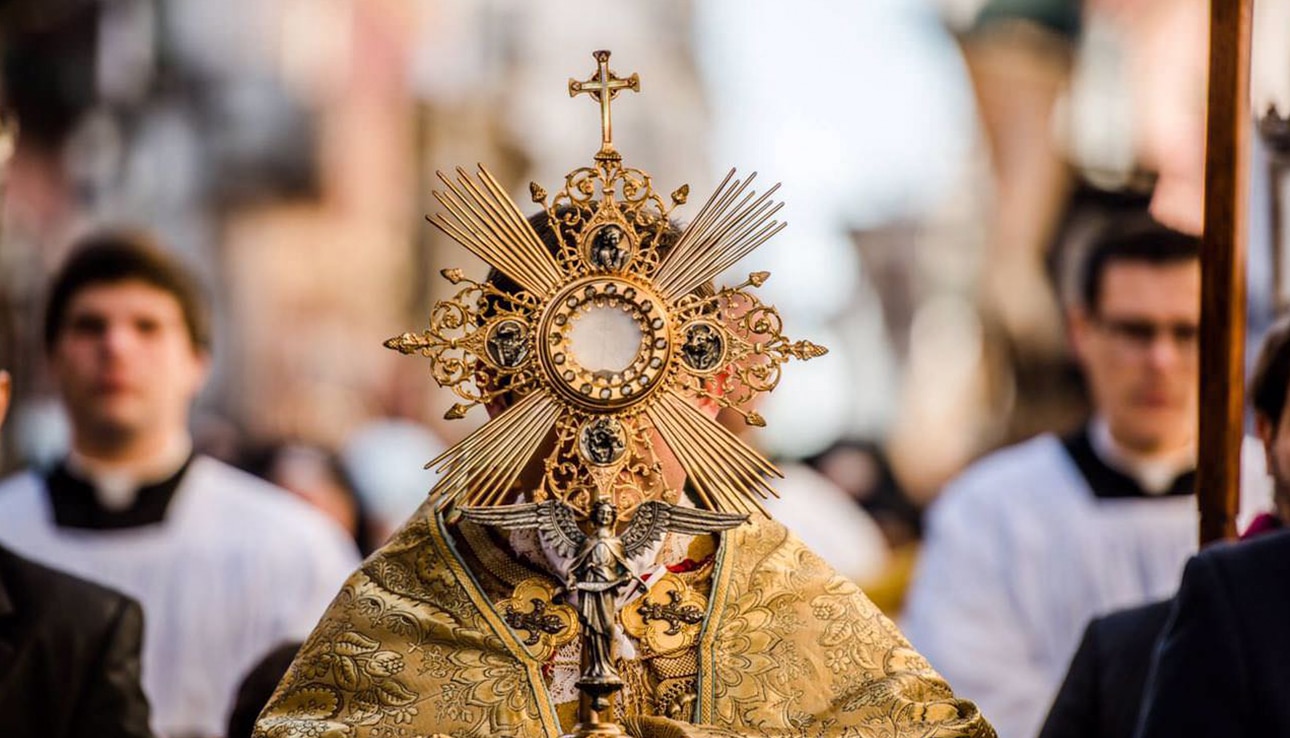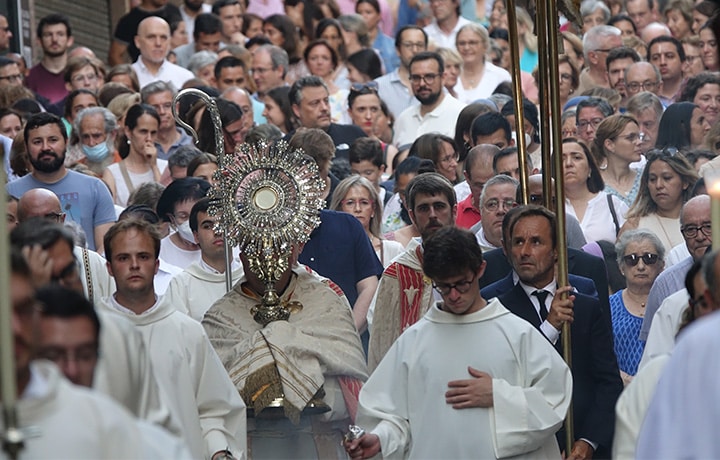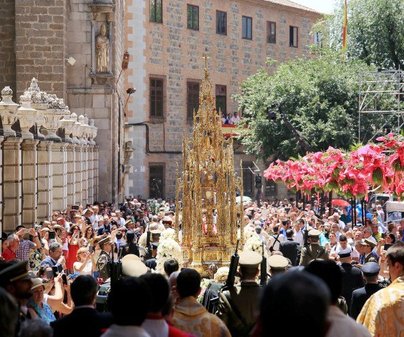
Corpus Christi, in Latin, Body of Christis one of the most important festivities of the Catholic Church because it is we celebrate the presence of Christ in the Eucharist. On that day, we the faithful acclaim the institution of the Eucharist, which took place on Holy Thursday, during the Last Supper. When Jesus Christ turned the bread and wine into his body and blood, and invited the apostles to commune with him.
We proclaim and reinforce our faith in the presence of Jesus Christ in the Blessed Sacrament, giving Him public adoration. That is why the celebrations of the feast of Corpus Christi include processions in the streets and public places in which the body of Christ is exhibited and accompanied by crowds of the faithful.
Corpus Christi is a movable feast of the Catholic religion, contemplated in the liturgical calendar. As such, is celebrated sixty days after Easter Sunday. It is celebrated on the Thursday following the Solemnity of the Most Holy Trinity, which takes place on the Sunday after the following Sunday. Pentecost.
Thus, the feast of Corpus Christi is the Thursday following the ninth Sunday after the first full moon of spring in the northern hemisphere, and of autumn in the southern hemisphere. Corpus Christi 2024 will be celebrated this Thursday, May 30.
What is Corpus Christi and what is its purpose? St. Josemaría Escrivá reminds us that On the feast of Corpus Christi, we Christians meditate together on the depth of the Lord's love, which led him to remain hidden under the sacramental species.
"I would like that, in considering all of that, to become aware of our mission as Christians, to turn our eyes towards the Holy Eucharist, towards Jesus who, present among us, has constituted us as his members.You are the body of Christ and members united to other members. Our God has decided to remain in the Tabernacle to nourish us, to strengthen us, to divinize us, to give efficacy to our task and to our efforts. Jesus is simultaneously the sower, the seed and the fruit of the sowing: the Bread of eternal life".
He continues: "This continually renewed miracle of the Holy Eucharist has all the characteristics of Jesus' way of acting.. Perfect God and perfect man, Lord of heaven and earth, He offers Himself to us as our sustenance, in the most natural and ordinary way. Thus he has been waiting for our love for almost two thousand years. It is a long time and it is not a long time: for, when there is love, the days fly."
"For me the Tabernacle has always been Bethany, the quiet and peaceful place where Christ is."
Homily on devotion to the Blessed Sacrament. May 28, 1964. St. Josemaría on the feast of Corpus Christi.
The celebration emerged during the 13th century. At Cornillon Abbey, its prioress, St. Juliana, had a great devotion to the Blessed Sacrament. One day, she obtained permission to hold a special celebration in her honor that soon spread throughout Germany.
Thus, The first Corpus Christi celebration took place in 1246 in the city of Liège, in present-day Belgium.
Almost 20 years later, in 1263. In the city of Bolsena (Italy), the so-called miracle of Bolsena took place. Where a priest, who was celebrating the Holy Mass, when he pronounced the words of consecration, blood began to flow from the host.
Pope Urban IV instituted the feast of Corpus Christi in 1264 by means of the bull Transitururs de hoc mondeThe celebration was to be held on the Thursday after the octave of Pentecost.
That is why Corpus Christi is not always celebrated on the same day. The day of the celebration was always on Thursday, but since 1990, when this day ceased to be a holiday, the festivity was moved to Sunday. In fact, although the liturgical solemnity is on Sunday, several localities celebrate the procession on Thursday. ToledoThe procession, in Spain, is one of the most spectacular and well cared for processions.
For this solemnity St. Thomas Aquinas was commissioned to prepare the texts for the Office and Holy Mass. of the day, including hymns such as the Pange Lingua, as the Tantum Ergothe Panis angelicus or the Adoro te devote.
Later, at the Council of Vienne in 1311, Pope Clement V regulated the processional procession inside the temples, and it was Pope Nicholas V who, in 1447, carried out the procession with the Blessed Sacrament through the streets of Rome.
Subsequently, the Council of Trent, held in 1551, approved the decree On the Most Blessed Sacrament of the Eucharist. In it, the importance of celebrating and venerating the Blessed Sacrament of the altar during the feast of Corpus Christi is recognized.
"Let us widen our hearts."
"As a peculiar celebration of this solemnity is the procession born of the piety of the Church; in it the Christian people, carrying the Eucharist, go through the streets with a solemn rite, with songs and prayers, and thus render public testimony of faith and piety towards this sacrament." canon 386 of the Ceremonial of Bishops.
Although the bull did not speak of any parade, the feast soon began to be crowned with a procession in which the consecrated host in a monstrance is taken out into the street. The first processions were held in Cologne (Germany), Paris (France) and the Italian cities of Genoa, Milan and Rome. In Spain, the processions of Ponteareas and Toledo are of International Tourist Interest.

In our country, the celebration of Corpus Christi has had and still has special roots. Numerous cities celebrate it with solemnity, the procession with the Holy Sacrament is joined by popular celebrations that make this feast a very important moment of the year.
The procession is especially solemn, the streets are decorated with ornaments on balconies and carpets of aromatic plants; altars are erected along the route of the procession, even the walls of the cathedrals are covered with tapestries.
Accompanying the Blessed Sacrament are the members of the clergy, the faithful and brothers and sisters of confraternities and brotherhoods, the members of the Nocturnal Adoration, the children who have received their First Communion that year, and together with all of them, the civil and military authorities, and even the academic institutions.

Corpus Christi in Seville and Guadix
In some cities such as Seville or Guadix (Granada), the seises, a group of children who dance in front of the Blessed Sacrament during the procession, will also be present.
Once again, popular art is present through multiple elements around this solemnity, especially the monstrances. This piece, made of gold, silver or other noble metal, is used to place the Blessed Sacrament in it and thus be exposed for the veneration and adoration of the faithful. Many of them are framed in a templete or throne that facilitates its transfer in the procession. They are elements of great artistic and material value, standing out among many, those of Toledo, Cordoba, Seville and Baeza.
As a curiosity there is a city with that name in the United States: Corpus Christi, Texas.
OpusDei.org
Turismocastillalamancha.es
Diocesisdehuelva.es
Catedraldesantiago.es